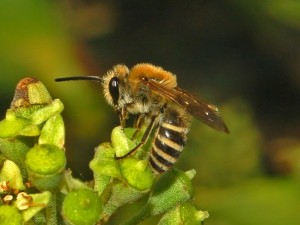OK, two bee posts in two days, but this was the most interesting thing I learned today (apart from the fact that potassium permanganate is used to treat weeping skin blisters as a last resort) whilst listening to a Radio 4 podcast.
First seen in 2001 the Ivy Bee ( Colletes hederae )is slowly progressing up the British Isles as shown on the survey map. These bees start to fly around the end of August and have around a six week flight window coinciding with the flowering period of ivy. Although I haven’t seen one they apparently look like furry ginger wasps.
As with many solitary bees these dig a hole in the ground in which to lay their eggs. One pair will have around 10 offspring with up to 18 in a good year. In order to make sure the larva can survive for 10 to 11 months underground they provision the chamber where the egg is laid with up to 3million grains of pollen and nectar – this takes about 6 trips for each chamber – quite a task if you only live for about three weeks!
Although these bees are doing well – there is no need to worry – as with other bees, the males don’t sting and the females are very docile. As they have recently evolved they don’t yet have any predators here that have evolved with them and, as they don’t appear to pose any threat to native insects, let’s hope that they continue to flourish. I’ll be setting a reminder in my calendar to look for them next September. Looking at photos of them that I have found around the inter web I am fairly hopeful that I might recognise one if I see it. I have included a photo below from Wikipedia taken by Hectonichus – maybe ginger humbugs was a good description!
